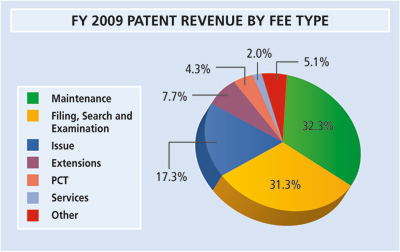The USPTO’s Proposed Fee Increase – Potential Effects to Stakeholders
By: Michael A. Leonard II
As with the economy in general, 2009 was a rough year for the USPTO from a fiscal standpoint. Due to declining revenue from a number of sources, the USPTO’s fund
balance with the Treasury dropped from $1.43 billion in FY 2008 to $1.31 billion in FY 2009. To address the fiscal shortcoming, as reported by
PatentlyO, a 15% increase of substantially
all fees, allowing the USPTO to set its own fees, and allowing the USPTO to retain and spend collected fees even if the Office is over budget are all on the table.
During FY 2009, average pendencies for applications also rose. The average pendency of an application to a first Office Action rose from 25.6 months in FY 2008 to
25.8 months in FY 2009 and the total average pendency rose from 32.2 months in FY 2008 to 34.6 months in FY 2009 (statistics from the USPTO annual reports found
Here). After being tasked to drastically reduce pendency
by Secretary of Commerce Gary Locke, Director Kappos has indicated that decreasing pendency is a top priority of his administration. The five year plan for the USPTO that
is currently being developed states that the USPTO will achieve a 3% increase in efficiency due to the reengineering of management and workflow processes, hire 1,000 former
Examiners and other experienced IP professionals that can hit the ground running, and initiate an interim fee increase for some fees that is projected to generate $224
million (see USPTO News Post). The combination of a fiscal
shortfall and the pressure to decrease pendency places added pressure on the USPTO to increase staff and fees. While the USPTO must find a way to be fiscally viable and all
of these measures are facially helpful towards achieving this aim, any fee increases will lead to further decreases in the number of applications filed and increases in
the number of abandonments, having a likely negative effect on corporations and private practitioners alike.
 |
FY 2009 was a year of unprecedented decreases in filings and increases in abandonments for the USPTO, driving home the fact that patents are not immune to economic
issues. New utility application filings decreased from 466,258 in FY 2008 to 457,966 in FY 2009. Abandonments rose from 205,674 in FY 2008 to 268,767 in FY 2009, a
31% increase. Also, the renewal rates for first stage maintenance fees fell from 83.1% in FY 2008 to 80.3% in FY 2009, the renewal rates for second stage maintenance
fees fell from 73.7% in FY 2008 to 63.5% in FY 2009, and the renewal rates for third stage maintenance fees fell from 49.2% in FY 2008 to 45.4% in FY 2009. The
relatively high 10.2% decrease in second stage maintenance fees paid perhaps reflects corporations taking a harder look at the actual value of their patents earlier
during a patent’s term. Fees associated with maintenance, filing, search and examination made up 63.6% of the USPTO’s revenue for FY 2009.

Accordingly, decreases in filed/pending applications and collected maintenance fees have a significant financial impact on the USPTO.
 |
Just as falling corporate revenues impacted filings and abandonments, a similar trend should also result from fee increases. Since corporations generally allocate a
fixed IP budget, increased cost of patent fees should cause an overall decrease in the number of applications filed. Further, Applicants will be forced to take a
harder look at whether to continue prosecution of applications. While lower rated applications that would have a narrow scope would be abandoned more quickly, some
that deserve a broader scope but are held up by bad rejections will be abandoned as well. As it is difficult to tell the future value of a particular patent with
certainty, some patents that would end up having value would probably be lost. Further, corporate portfolios would be somewhat reduced, making fewer tools available
for defending a patent suit against a competitor and reducing the value of the corporation in a subsequent acquisition. On the private practice side, the effect is
clear – fewer applications and more abandonments means less work.
Per the above, the recession of 2009 highlighted that patents are not untouchable assets that are immune to economic considerations. Thus, while on the USPTO side,
increased fees should increase revenue, the increase will not be by the overall value of the fee increase itself. As such, when projecting revenue from a fee increase,
a projected decline in revenue from filed applications, abandoned applications and a decline in maintenance fees paid should also be taken into account. Naturally, the
larger the fee increase, the greater the decline. Such decreases could be tempered be increases in IP budgets due to improving corporate earnings in a slowly improving
economy.
However, it should be noted that decreases in applications filed and increases in the number of abandoned applications have the contrary beneficial effect of reducing
pendency. As this is a stated top priority of the administration, it seems unlikely that the USPTO is ignorant of this fact.
It appears that a fee increase is likely as part of the USPTO’s plan to address its financial issues. The USPTO will likely benefit from both increased revenue and a
decrease in pendency. Unfortunately, while reduced pendency has long term benefits, it appears that corporations and private practitioners stand to gain little in the
short term other than higher costs and a reduced workload.
Do you think that the proposed USPTO fee increase will be beneficial, have no impact, or be detrimental to patent prosecution practice in the current economy?
